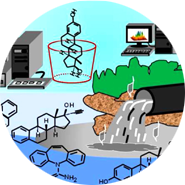Development of Analytical Methods for the Existing and Emerging Pollutants
Analytical method development involves the procedures that are used to quantify target pollutants in different matrices. Major challenges exist when the concentration of target pollutants is low and the matrix is highly complex. In such cases, sample preparation is performed before analysis. Sample preparation is used to achieve one or more of the following objectives:
- Clean-up of the complex matrix components that otherwise may interfere with the detection of the target pollutants.
- Enrichment of the target analytes to higher levels, so that they can be easily detected with an overall improvement in analytical figures of merit
- Conversion of analytes into their target instrument compatible derivatives.
Classical methods such as liquid-liquid extraction and solid-phase extraction are widely employed for sample preparation. These methods consume large volumes of hazardous solvents and reagents, thus raising concern about the safety of the environment and workers. The area of sample preparation is now inclined towards the development of solvent-less or solvent minimized extraction procedures. This research group is involved in developing miniaturized extraction techniques based on new materials and devices both for existing as well as emerging pollutants. The particular focus is on dispersive and membrane-based extraction strategies. This group also performs research and development activities to solve the challenges associated with the routine analysis of water, sediment, soil, and biota samples.
